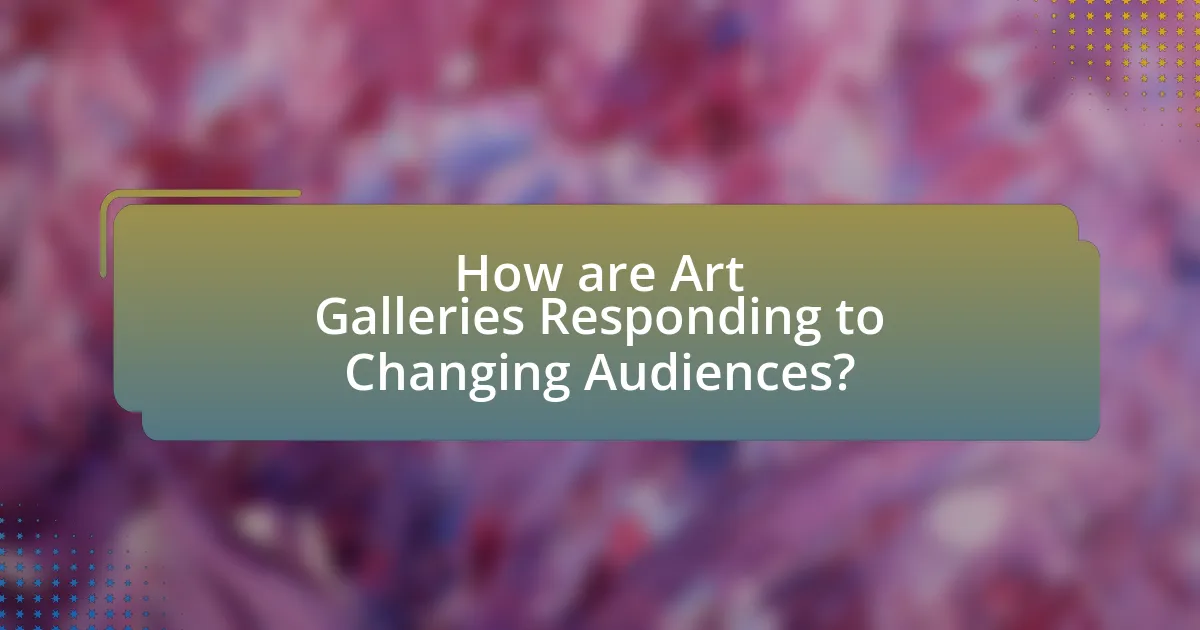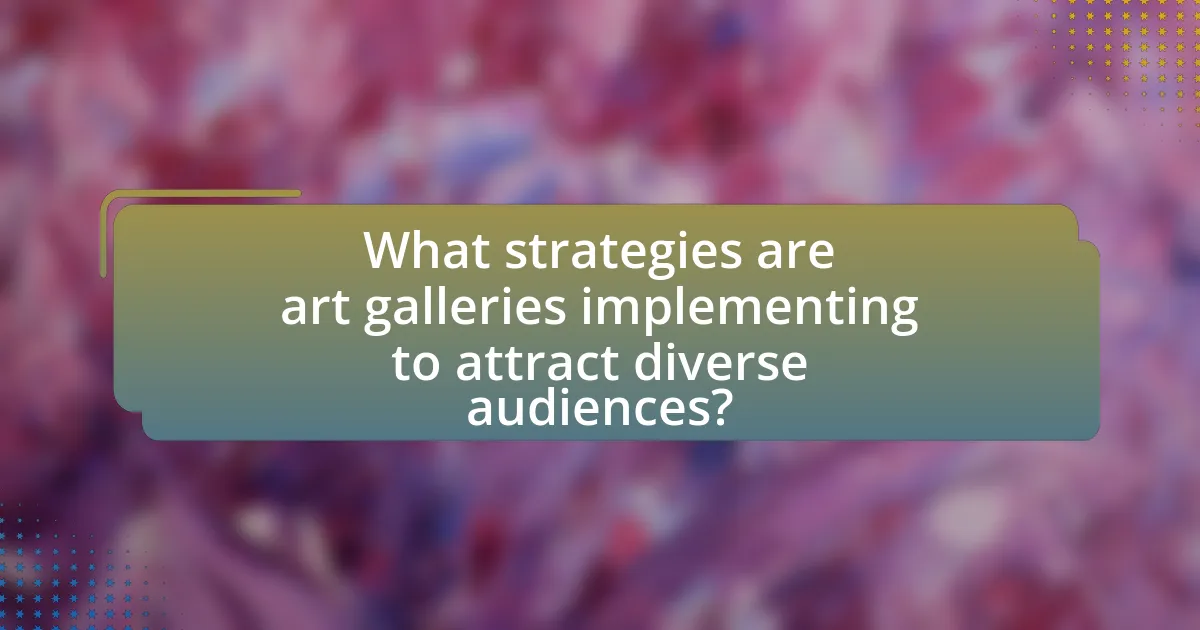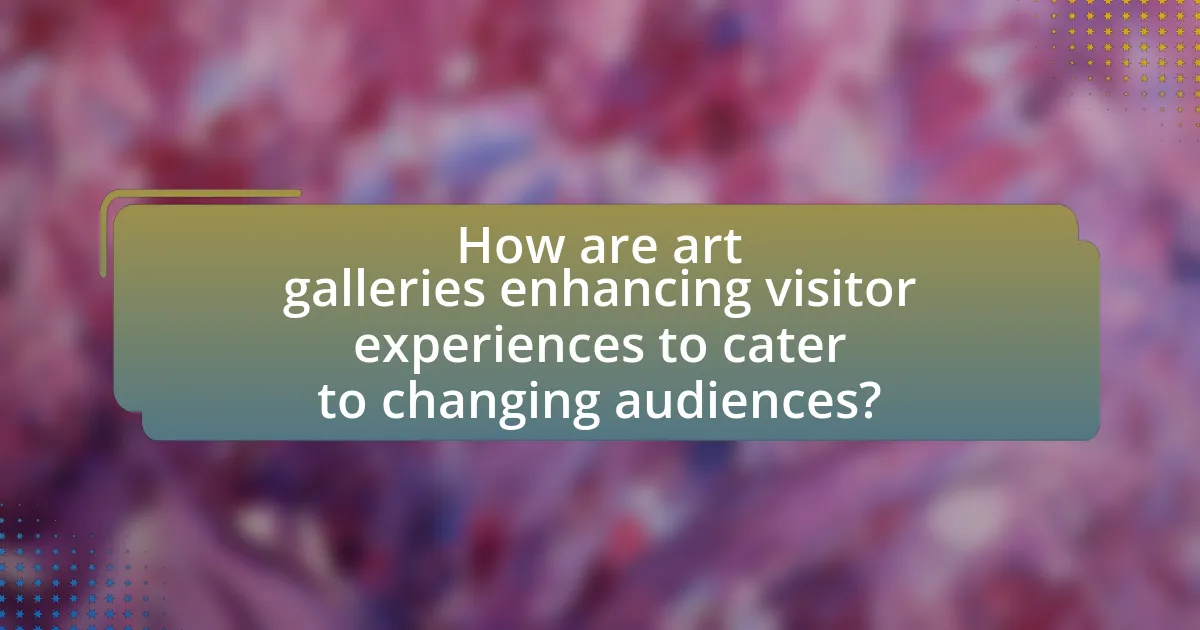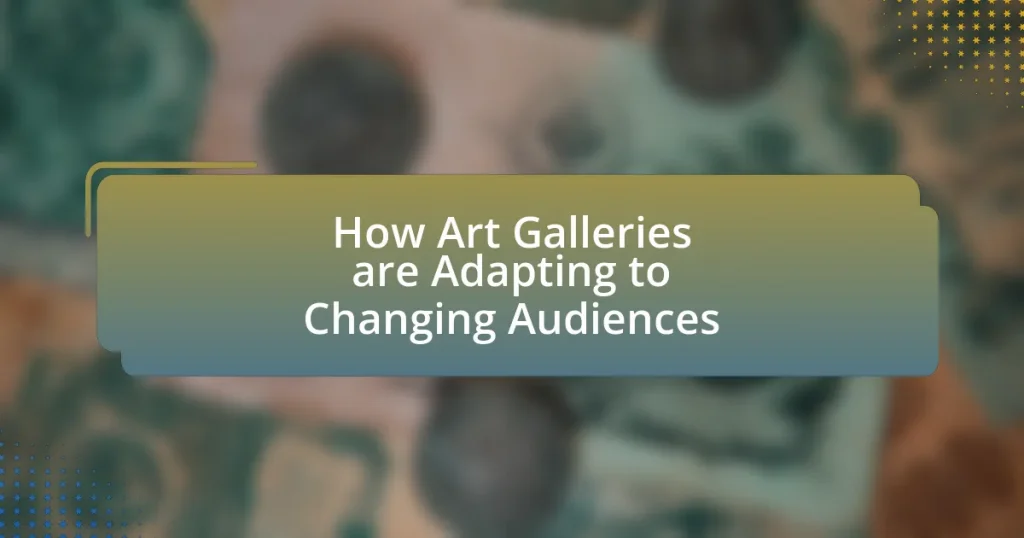Art galleries are increasingly adapting to changing audiences by implementing diverse programming, enhancing digital engagement, and fostering community involvement. Factors such as technological advancements, cultural shifts, and socioeconomic trends are reshaping audience demographics and preferences. Galleries are utilizing interactive technologies, virtual exhibitions, and social media to engage visitors, while also prioritizing inclusivity through community programs and collaborations with local artists. These strategies not only enhance visitor experiences but also ensure the relevance and sustainability of galleries in a competitive cultural landscape.

How are Art Galleries Responding to Changing Audiences?
Art galleries are responding to changing audiences by implementing diverse programming, enhancing digital engagement, and fostering community involvement. These strategies aim to attract a broader demographic and cater to evolving visitor expectations. For instance, many galleries now offer interactive exhibitions and workshops that encourage participation, reflecting a shift towards experiential learning. Additionally, the rise of virtual tours and online exhibitions has allowed galleries to reach global audiences, as evidenced by a 2021 report from the Art Basel and UBS Global Art Market Report, which highlighted a significant increase in online art sales during the pandemic. Furthermore, galleries are collaborating with local artists and organizations to create inclusive spaces that resonate with community values, thereby increasing accessibility and relevance in contemporary society.
What factors are influencing the changes in audience demographics for art galleries?
Changes in audience demographics for art galleries are influenced by factors such as technological advancements, cultural shifts, and socioeconomic trends. Technological advancements, particularly the rise of social media and online platforms, have made art more accessible, attracting younger audiences who engage with art digitally. Cultural shifts, including increased diversity and a growing emphasis on inclusivity, have led galleries to showcase a wider range of artists and perspectives, appealing to broader demographics. Socioeconomic trends, such as urbanization and changes in disposable income, also play a role, as more individuals in urban areas seek cultural experiences. These factors collectively reshape the audience landscape for art galleries, reflecting broader societal changes.
How has technology impacted audience engagement in art galleries?
Technology has significantly enhanced audience engagement in art galleries by providing interactive experiences and accessible information. Digital tools such as augmented reality (AR) and virtual reality (VR) allow visitors to immerse themselves in artworks, creating a more dynamic interaction. For instance, the use of AR applications enables viewers to see additional layers of information about the artwork, such as artist interviews or historical context, directly through their smartphones. According to a report by the American Alliance of Museums, 70% of museums have adopted digital technologies to improve visitor engagement, demonstrating a clear trend towards integrating technology in the gallery experience. This shift not only attracts a broader audience but also fosters deeper connections between visitors and the art.
What role do social and cultural shifts play in changing audience preferences?
Social and cultural shifts significantly influence audience preferences by altering values, interests, and behaviors. For instance, the rise of digital technology and social media has transformed how audiences engage with art, leading to a preference for interactive and immersive experiences. According to a 2021 report by the National Endowment for the Arts, 53% of adults in the U.S. reported attending arts events online, reflecting a shift towards digital consumption. Additionally, increasing awareness of social issues has prompted audiences to favor art that addresses themes of diversity and inclusion, as evidenced by the growing popularity of exhibitions that highlight underrepresented artists. These shifts demonstrate that as societal norms evolve, so too do the preferences and expectations of audiences in the art world.
Why is it important for art galleries to adapt to these changes?
It is important for art galleries to adapt to changes in audience preferences and behaviors to remain relevant and sustain visitor engagement. Adapting allows galleries to incorporate diverse programming, utilize technology for enhanced experiences, and create inclusive environments that resonate with a broader demographic. For instance, a study by the National Endowment for the Arts found that engaging younger audiences through digital platforms can significantly increase attendance and participation in cultural events. Therefore, adapting to these changes not only fosters community connection but also ensures the financial viability of galleries in a competitive cultural landscape.
What are the potential consequences of failing to engage new audiences?
Failing to engage new audiences can lead to decreased visitor numbers and reduced revenue for art galleries. This decline occurs because galleries rely on diverse audience participation to sustain their operations and fund exhibitions. According to a report by the National Endowment for the Arts, organizations that do not adapt to changing demographics and interests risk alienating potential visitors, which can result in a 30% drop in attendance over time. Additionally, without new audiences, galleries may struggle to secure funding and sponsorships, as many grants prioritize outreach and community engagement. This lack of financial support can hinder the gallery’s ability to host innovative exhibitions and programs, ultimately diminishing its cultural impact and relevance in the community.
How can adapting to changing audiences enhance the relevance of art galleries?
Adapting to changing audiences enhances the relevance of art galleries by ensuring that their exhibitions and programs resonate with contemporary societal interests and demographics. This responsiveness allows galleries to attract diverse visitor groups, thereby increasing attendance and engagement. For instance, galleries that incorporate digital technology and social media outreach have seen a rise in younger audiences, as evidenced by a 2019 study from the National Endowment for the Arts, which reported that 53% of millennials engage with art through online platforms. By aligning their offerings with the evolving preferences of their audiences, art galleries can maintain cultural significance and foster community connections.

What strategies are art galleries implementing to attract diverse audiences?
Art galleries are implementing strategies such as community engagement programs, inclusive exhibitions, and targeted marketing campaigns to attract diverse audiences. Community engagement programs involve partnerships with local organizations to host events that resonate with various cultural groups, thereby fostering a sense of belonging. Inclusive exhibitions showcase artists from underrepresented backgrounds, ensuring that diverse perspectives are highlighted and appreciated. Targeted marketing campaigns utilize social media and digital platforms to reach specific demographics, promoting events and exhibitions that align with their interests. These strategies are supported by research indicating that galleries that prioritize inclusivity see increased attendance and community support, demonstrating their effectiveness in attracting a broader audience.
How are art galleries utilizing digital platforms to reach new audiences?
Art galleries are utilizing digital platforms by creating virtual exhibitions and leveraging social media to engage with broader audiences. Virtual exhibitions allow galleries to showcase their collections online, making art accessible to individuals who may not visit in person, as evidenced by the increase in online viewership during the COVID-19 pandemic, where some galleries reported a 300% rise in virtual attendance. Additionally, social media platforms like Instagram and Facebook enable galleries to share artwork, promote events, and interact with followers, effectively reaching younger demographics who are more active online. This strategic use of digital tools not only enhances visibility but also fosters community engagement and participation in the arts.
What types of online exhibitions are becoming popular among galleries?
Virtual reality exhibitions are becoming popular among galleries as they offer immersive experiences that engage audiences in innovative ways. These exhibitions allow viewers to explore art in a three-dimensional space, enhancing interaction and emotional connection with the artwork. Additionally, themed online exhibitions focusing on specific artists, movements, or social issues are gaining traction, as they cater to niche audiences and foster community discussions. According to a report by Art Basel and UBS, 70% of galleries have increased their online presence, indicating a shift towards digital platforms to reach broader audiences.
How do social media campaigns influence audience engagement?
Social media campaigns significantly enhance audience engagement by facilitating direct interaction and fostering community among users. These campaigns leverage platforms like Instagram and Facebook to create visually appealing content that resonates with target audiences, leading to increased likes, shares, and comments. For instance, a study by Sprout Social found that 70% of consumers feel more connected to brands with a strong social media presence, indicating that effective campaigns can cultivate loyalty and encourage participation. Additionally, social media allows for real-time feedback and dialogue, enabling art galleries to adapt their offerings based on audience preferences, thus further driving engagement.
What role does community involvement play in audience adaptation?
Community involvement is crucial for audience adaptation in art galleries as it fosters a sense of ownership and relevance among local populations. Engaging the community allows galleries to tailor their exhibitions and programs to reflect the interests and cultural backgrounds of their audience, thereby enhancing visitor experience and attendance. For instance, studies have shown that galleries that actively involve community members in decision-making processes see increased participation rates, as evidenced by the 2019 report from the National Endowment for the Arts, which highlighted that community-driven initiatives led to a 30% rise in local attendance at participating galleries. This demonstrates that when galleries prioritize community engagement, they effectively adapt to the evolving preferences and needs of their audiences.
How are art galleries collaborating with local artists and organizations?
Art galleries are collaborating with local artists and organizations by hosting joint exhibitions, providing platforms for local talent, and engaging in community outreach programs. These collaborations often involve galleries curating shows that feature the work of local artists, thereby increasing visibility and support for the local art scene. For instance, many galleries partner with community organizations to create events that promote cultural exchange and accessibility, such as workshops and artist talks. This approach not only enriches the gallery’s offerings but also fosters a sense of community and shared purpose, as evidenced by initiatives like the “Local Artist Spotlight” series, which highlights emerging artists and encourages community involvement.
What community programs are effective in attracting diverse visitors?
Community programs that effectively attract diverse visitors include cultural festivals, educational workshops, and outreach initiatives tailored to underrepresented groups. Cultural festivals celebrate various heritages and encourage participation from different communities, fostering inclusivity and engagement. Educational workshops, particularly those that focus on local history or art techniques relevant to diverse cultures, provide opportunities for learning and connection. Outreach initiatives, such as partnerships with schools and community organizations, help to create awareness and accessibility, ensuring that art galleries reach a broader audience. These programs have been shown to increase visitor diversity, as evidenced by studies indicating that galleries implementing such initiatives report higher attendance from varied demographic groups.

How are art galleries enhancing visitor experiences to cater to changing audiences?
Art galleries are enhancing visitor experiences by integrating technology, offering interactive exhibits, and providing diverse programming to engage changing audiences. For instance, many galleries now utilize augmented reality (AR) and virtual reality (VR) to create immersive experiences that attract tech-savvy visitors. Additionally, interactive installations allow visitors to engage with art in a participatory manner, fostering a deeper connection. According to a 2021 report by the American Alliance of Museums, 70% of museums have adopted digital tools to enhance visitor engagement, reflecting a significant shift towards accommodating diverse audience preferences. Furthermore, galleries are curating programs that include workshops, talks, and community events, catering to a broader demographic and encouraging inclusivity.
What innovative exhibition formats are being adopted by art galleries?
Art galleries are adopting innovative exhibition formats such as immersive installations, virtual reality experiences, and interactive displays. These formats engage audiences more deeply by allowing them to participate in the art rather than just observe it. For instance, immersive installations often transform gallery spaces into multi-sensory environments, enhancing emotional connections with the artwork. Virtual reality experiences enable viewers to explore art in a digital realm, broadening accessibility and appeal. Interactive displays encourage visitor participation, fostering a sense of community and dialogue around the art. These approaches reflect a shift towards more engaging and inclusive experiences that cater to diverse audience preferences.
How do immersive experiences impact audience engagement?
Immersive experiences significantly enhance audience engagement by creating interactive and participatory environments that foster emotional connections. Research indicates that when audiences actively participate in an experience, their attention and retention levels increase, leading to a deeper understanding and appreciation of the content presented. For instance, a study published in the Journal of Cultural Heritage Management and Sustainable Development found that immersive art installations resulted in a 40% increase in visitor satisfaction and a 30% increase in time spent in galleries compared to traditional exhibits. This evidence demonstrates that immersive experiences not only attract larger audiences but also encourage them to engage more meaningfully with the art.
What role does interactive technology play in enhancing visitor experiences?
Interactive technology significantly enhances visitor experiences by providing immersive and engaging interactions that foster deeper connections with art. For instance, augmented reality applications allow visitors to visualize artworks in new dimensions, while interactive displays enable personalized storytelling, making the art more relatable. Research indicates that galleries utilizing interactive technology report increased visitor satisfaction and engagement levels, with studies showing that 70% of visitors prefer interactive exhibits over traditional displays. This shift not only attracts diverse audiences but also encourages repeat visits, demonstrating the effectiveness of interactive technology in modern art galleries.
How are galleries addressing accessibility and inclusivity for diverse audiences?
Galleries are addressing accessibility and inclusivity for diverse audiences by implementing various strategies such as physical modifications, programming changes, and community engagement initiatives. For instance, many galleries are enhancing physical accessibility by installing ramps, elevators, and tactile pathways to accommodate individuals with mobility challenges. Additionally, galleries are offering sensory-friendly hours and providing materials in multiple languages to cater to non-native speakers and individuals with sensory sensitivities.
Moreover, community engagement initiatives, such as partnerships with local organizations representing marginalized groups, help galleries to better understand and meet the needs of diverse audiences. According to a report by the National Endowment for the Arts, 60% of arts organizations have increased their focus on accessibility in recent years, demonstrating a commitment to inclusivity. These efforts collectively contribute to creating a more welcoming environment for all visitors.
What measures are being taken to improve physical accessibility in galleries?
Art galleries are implementing various measures to enhance physical accessibility for all visitors. These measures include the installation of ramps and elevators to facilitate wheelchair access, the provision of tactile guides and audio descriptions for visually impaired individuals, and the redesign of exhibition spaces to ensure clear pathways. According to the Americans with Disabilities Act (ADA), compliance with accessibility standards is essential, and many galleries are actively working to meet or exceed these requirements to create an inclusive environment.
How are galleries ensuring diverse representation in their programming?
Galleries are ensuring diverse representation in their programming by actively curating exhibitions that feature artists from various backgrounds, including underrepresented communities. This approach is supported by initiatives such as partnerships with organizations focused on diversity in the arts, which help galleries identify and promote diverse talent. For example, the National Endowment for the Arts reported that funding for projects aimed at increasing diversity in the arts has risen, indicating a broader commitment to inclusive programming. Additionally, galleries are implementing community engagement strategies that involve local voices in the decision-making process, further enhancing representation and relevance in their exhibitions.
What best practices can art galleries adopt to successfully adapt to changing audiences?
Art galleries can successfully adapt to changing audiences by implementing inclusive programming, leveraging digital platforms, and engaging in community outreach. Inclusive programming ensures that diverse voices and perspectives are represented, which can attract a broader audience. For instance, galleries that feature artists from various backgrounds have seen increased attendance and engagement. Leveraging digital platforms, such as virtual tours and social media, allows galleries to reach audiences beyond their physical locations; a study by the National Endowment for the Arts found that online engagement can significantly boost visitor numbers. Community outreach initiatives, such as partnerships with local schools and organizations, foster relationships and encourage participation from different demographic groups, enhancing the gallery’s relevance and appeal.















